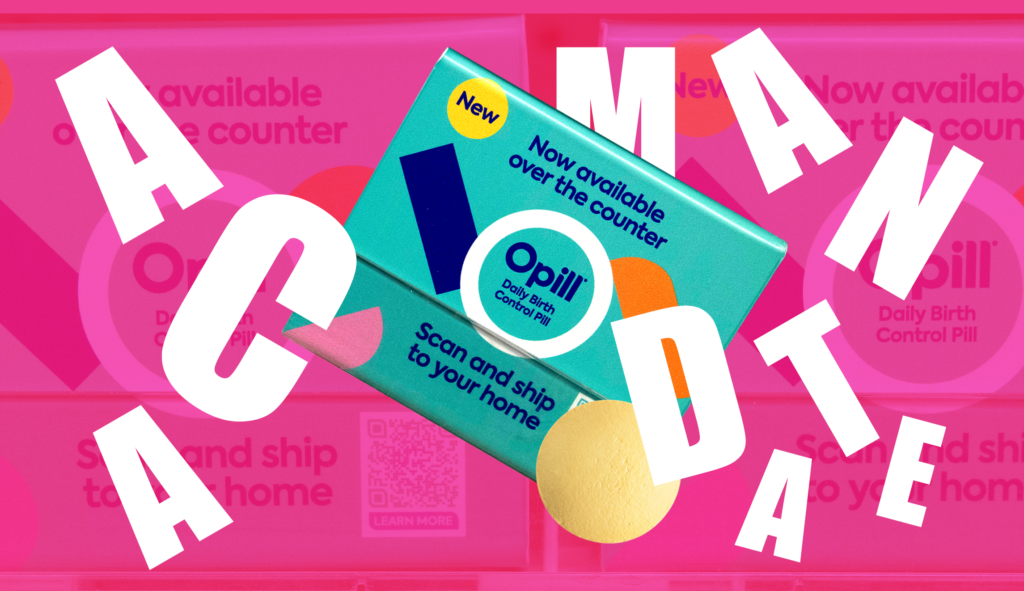
More than six decades after Norgestrel was patented, the progestin-only birth control pill has debuted on drug store shelves and online as Opill. It’s the first oral contraceptive in the country granted nationwide over-the-counter status by the Food and Drug Administration.
Already, retailers such as Amazon, Target, CVS, and Walmart have listed a three-month supply of Opill for roughly $16 per month. Its price points and availability prove that deregulating birth control, rather than the Affordable Care Act’s legally dubious contraception mandate, is a pro-life, pro-capitalist, and pro-religious liberty solution to the persistent demand for abortion.
While the ACA did coincide with a marked reduction in the nation’s abortion rate, it wasn’t because of the contraception mandate’s demand that private insurers pay for oral contraception, which was not increasingly used after the mandate. Instead, the mandate led to a 23% increase in long-acting reversible contraception, largely hormonal and copper IUDs, which have near-zero failure rates.

But because the mandate prohibited cost sharing with insured patients, totally elastic demand for oral contraception led to list prices nearly doubling from when the ACA went into effect in 2014 to 2020, compared to a 40% increase in prescription drug prices and a 10% increase in over-the-counter drug prices.
The majority of women in the country were insulated from the economic ramifications of the contraception mandate by their insurers, but nearly 10 million women who lack insurance were not. On top of the out-of-pocket expenses for a physician’s visit to obtain a prescription for oral contraceptives, uninsured women reported paying an average of $268 per year on birth control pills in a 2017 to 2018 Medical Expenditure Panel Survey.
Already, Opill provides a solution. At $192 per year at Walmart and other national retailers, Opill provides uninsured women with a birth control pill at just 72% of the list price of the average. And because Opill doesn’t require a prescription, uninsured women are also saved the copay required for a doctor’s visit. Empirical economics indicate that prices will only go down from here.
Whereas the Bureau of Labor Statistics’s prescription drug index increased by 20% from 2014 to the start of 2022 — that is, even before the worst inflationary crisis in 40 years began in full — over-the-counter drug prices actually decreased by 2%. Some of the increase in prescription drug prices is necessary and justified. Just think of a drug like Ozempic that has a nominal list price near the thousands because Novo Nordisk must recoup potential tens of billions of dollars in research and development. But hormonal birth control is primed for the ideal OTC debut: It comes in plenty of decades-old formulations, and contrary to much of the misinformation on TikTok, it is safer than Tylenol.
Consider that emergency contraception such as Plan B, which has a much higher hormone content than daily contraception pills, has been available over the counter for 11 years now. And whereas Plan B is only 89% effective when taken within 72 hours of unprotected sex, Opill is 98% when taken every day within the same three-hour window. (Emergency contraception, like all forms of hormonal birth control, is incapable of aborting an extant, implanted pregnancy, but it has a failure rate more than five times greater than that of Opill.)
For a second potential shot at the presidency, over-the-counter Opill could be just the start for Donald Trump. The former president, who has correctly embraced pro-life federalism, supporting only state-level bans with exceptions for rape, incest, and the life of the mother, could focus his national efforts on diminishing demand for abortion with further deregulation of oral contraception.
In a study of women from 2014, just 13% of abortion patients reported using oral contraceptives. But more than a quarter used condoms, which are only 87% with typical use, and 7.4% used withdrawal, a “birth control” method so ineffective it cannot even accurately be described as such. (About 1 in 5 couples who rely on pulling out will conceive within a year.) More than half were using zero birth control method.
CLICK HERE TO READ MORE FROM THE WASHINGTON EXAMINER
We don’t have terribly recent data confirming why so many abortion recipients are using such ineffective forms of birth control. But a massive Centers for Disease Control and Prevention study of nearly 200,000 women from 2004 to 2008 found that nearly a quarter of teenage mothers who weren’t using any birth control when they conceived an unwanted pregnancy said their partner “did not want to use contraception.” Another 13% said they “had trouble getting pregnant.” Access to over-the-counter oral contraception as an invisible and more effective alternative to condoms would prevent a substantial share of those pregnancies.
In a second Trump term, Republicans could push the FDA to authorize over-the-counter status to even more formulations for birth control pills, including the combination pills, which don’t need to be taken at the same time every day and are thus more effective with typical use. In the short term, we can all look at the likely lull in the price of Opill as proof that deregulation doesn’t just improve the greatest good for the greatest number as a matter of economics. It also helps empower women to make proactive choices before conceiving an unwanted pregnancy.






